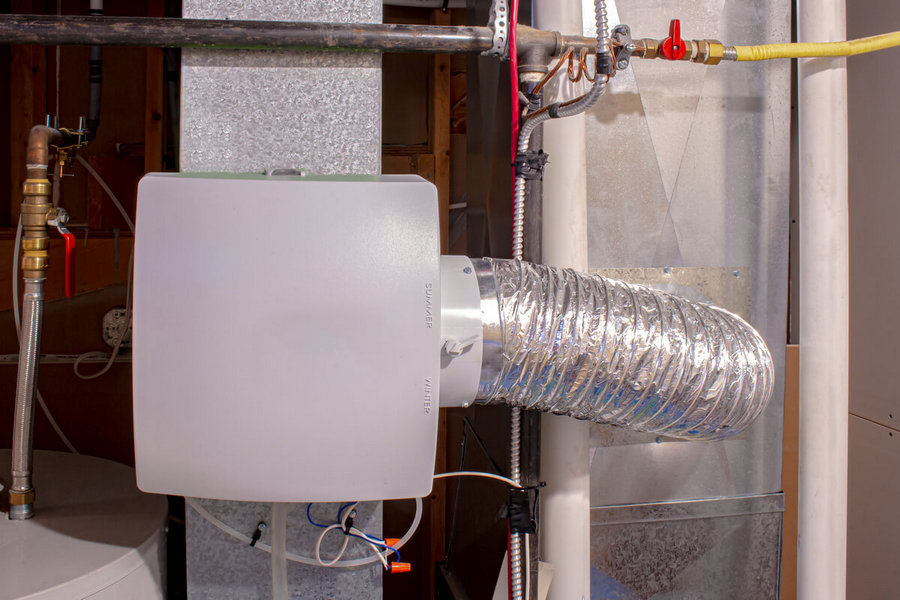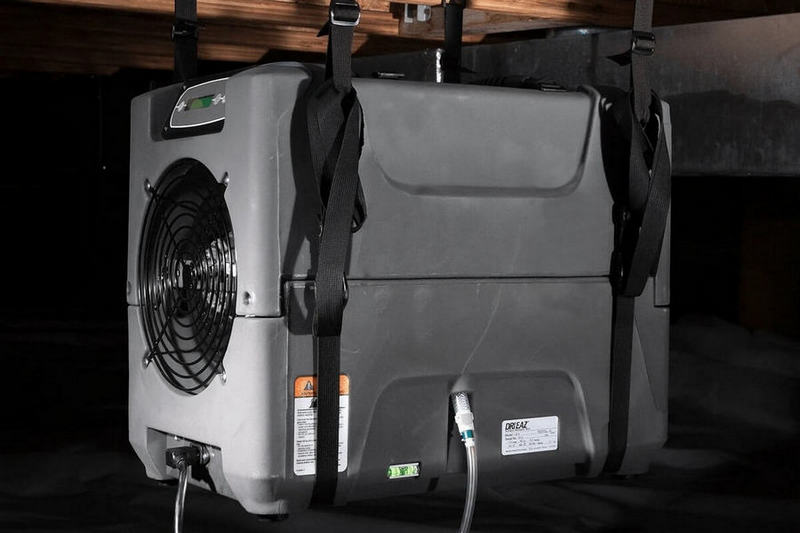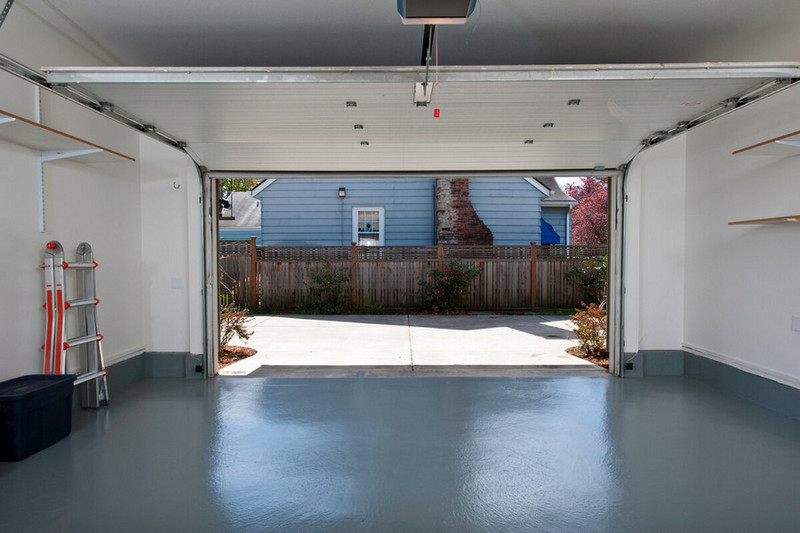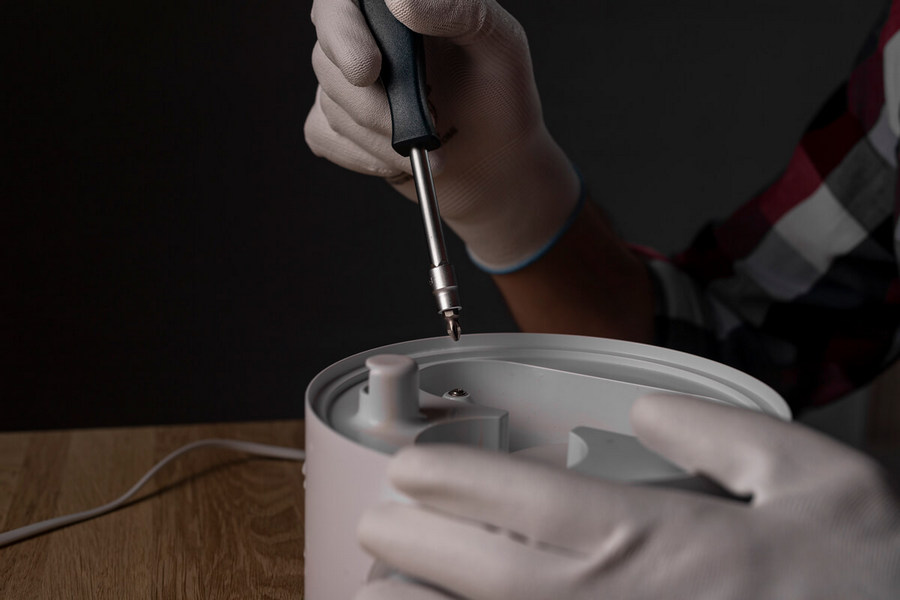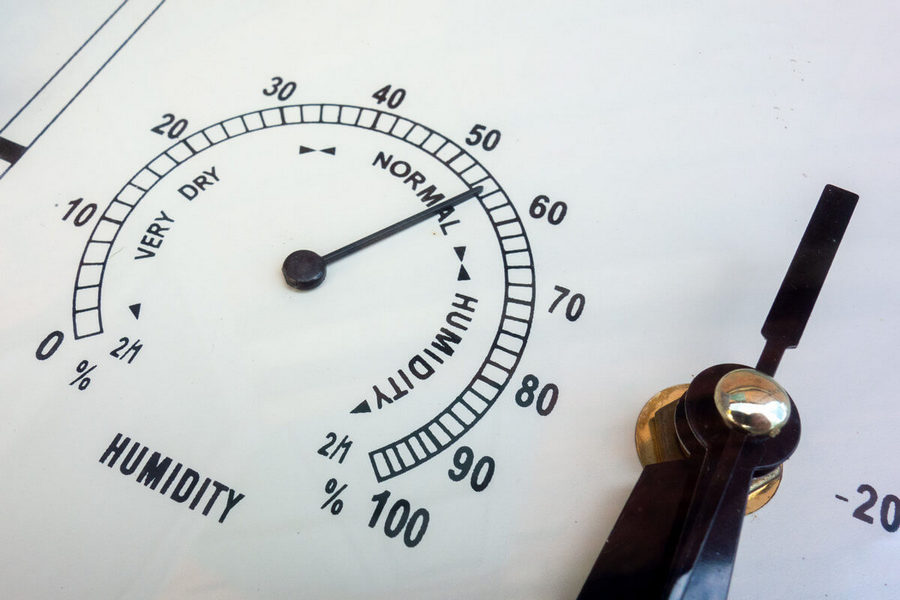High levels of humidity inside your home are not only uncomfortable but also pose a considerable health risk. From mold and mildew to termites and other allergens, excess humidity inside your home is a recipe for disaster.
You might think that air conditioners are enough to keep the moisture at bay, but you’d be wrong. Instead, what you need is something that explicitly targets the excess humidity all over your house. That’s why you need the ducted whole house dehumidifier.
Indeed, ducted dehumidifiers for your home are an efficient and practical way to keep the humidity at comfortable levels, regardless of the season. But before we get into an in-depth the best ducted whole house dehumidifier review, you need to understand what these appliances are and how they work.
Our Top Picks:
Most Energy Efficient Ducted Dehumidifier: AprilAire E100
Best Portable Whole House Dehumidifier: AlorAir HDi90
What Are Ducted Whole House Dehumidifiers and How Do They Work?
A ducted whole house dehumidifier is an add-on appliance to your inline HVAC system that removes excess moisture and humidity from your entire house. Much like central air conditioners, this microwave-sized appliance uses ducts running through your entire house to bring down humidity to bearable levels in each room.
On the other hand, a ducted whole-home dehumidifier system explicitly targets the air moisture content inside your home. The appliance works by sensing when humidity levels inside your home exceed the ideal relative humidity (RH) levels— between 50 to 60 percent RH in summers and 30 to 40 percent RH in winters.
The high humidity levels subsequently trigger the dehumidifier to pump the indoor air through the return ducts and run it over a cold coil containing refrigerant. Then, as the laws of physics dictate, the moisture in the hot, humid air condenses on the cold coil, and the liquid eventually drains out. The dehumidified air is then redirected back throughout your house.
Why Do You Need a Whole House Dehumidifier Over a Portable Room Dehumidifier?
Dehumidifiers also come in compact, portable forms which cost less and are more consumer-friendly. So, why shouldn’t you use a portable room dehumidifier instead? Here’s why:
- Whole house dehumidifiers reduce the humidity levels all over your house, whereas portable room dehumidifiers only work in a single room. Hence, whole-home dehumidifiers are more practical for a large home.
- Since a whole-home dehumidifier reduces the humidity throughout your house, your air conditioner won’t have to work as hard. Portable dehumidifiers will do the opposite.
- Inline ducted whole house dehumidifiers have a larger capacity (amount of moisture, in pints or liters, removed in 24 hours) than their portable counterparts. The former can go up to 100 pints or 47.32 liters, while the latter maxes out at 50 pints or 23.66 liters.
- Whole home dehumidifiers are typically tucked out of sight (usually in basements). On the other hand, portable room dehumidifiers take up floor space and aren’t easy on the eyes.
At the end of the day, whole house dehumidifiers are much more practical and efficient for large homes. However, portable room dehumidifiers are ideal for small apartments or single rooms.
Check out this similar post: Top 5 under-house dehumidifiers
Tips for Picking the Right Ducted Whole House Dehumidifier
Ducted whole house dehumidifier systems often come with a whole list of specs. It is your job to figure out how well these specs suit your dehumidification needs.
Dehumidification capacity
Before anything else, try and gauge how humid your house actually is. Some tell-tale signs of high humidity in your house are:
- A stale smell in the air
- Mold spots in your bathroom
- Condensation on your windows
- Increased allergens, such as dust mites or mildew, inside your house
Otherwise, you can simply use a hygrometer – a device that tracks both temperature and humidity inside your house.
Once you know how severe the problem is, you can then determine the dehumidification capacity you need. The capacity refers to the volume, in pints or liters, of moisture that can be removed per day (24-hour period). The larger your indoor space is, the higher capacity you will need.
Airflow
In addition to the capacity, measuring the airflow is equally important. Simply put, airflow refers to the volume of air in cubic meters that passes through the dehumidifier in a 24-hour period. In other words, the airflow tells you how much air in your indoor space the dehumidifier can handle in a day.
The airflow is usually given as the air volume in the dehumidifier specifications. Additionally, it might also use a different unit of time, such as minutes. Most commonly, you’ll find the airflow given in cubic feet per minute (CFM).
Coverage area
The coverage area is the final variable in the equation that you need to figure out the size of your dehumidifier. Essentially, the coverage area is the total area inside your house on which the dehumidifier will act.
Let’s say that the total area of your house is 2,500 square feet, with a ceiling height of 9 meters. Thus, the cubic volume (or coverage area) will be 2500 ✖ 9 = 22,500 cubic feet.
Let’s say you choose a dehumidifier with an airflow of 400 CFM or 576,000 cubic feet per day. Hence, the dehumidifier will pump air through the system a total of 576,000÷22,500= 25 times in a single day or once every hour.
Energy efficiency
Whole-house dehumidifiers will naturally use a lot of energy and rack up your electricity bill. They range from 214 Watts to 970 Watts of power. On average, a dehumidifier will utilize 0.427 Kilowatts per hour.
It is important to note that low wattage doesn’t necessarily mean higher energy efficiency. In fact, the same dehumidifier might be more energy-efficient in one environment than another, depending on coverage area, climate, and countless other factors. To make things easier for yourself, try to look for an “Energy Star” stamp of approval. A certification from Energy Star guarantees that a dehumidifier is energy-efficient.
Best Ducted Whole House Dehumidifiers
Now that you know what to look out for when buying the ducted whole house dehumidifier, let’s go over some of the best options on the market.
1. Aprilaire E100 Ducted Whole Home Dehumidifier
If you want to improve the air quality in your home without amping up the electricity bill, the Aprilaire E100 Ducted Whole Home Dehumidifier is hands-down your best choice. This Energy-Star-certified dehumidifier controls the humidity levels in every nook and cranny in your home, be it your spacious living room or a crawlspace with up to 5,500 square feet of coverage area.
While a hefty investment up-front, the built-to-last E100 will keep the mold, mildew, termites, and odor at bay for years to come.
The Aprilaire E100 was awarded the title of the most energy-efficient whole house dehumidifier in 2021, with a capacity of 100 pints per day. Moreover, this device is exceptionally user-friendly and requires minimal knowledge about your HVAC system. Following the initial installation, the E100 takes over with its smart sensing technology and automatic drainage system.
All in all, the Aprilaire E100 dehumidifier is perfect for both commercial and large home use, especially if you’re not a fan of regular maintenance.
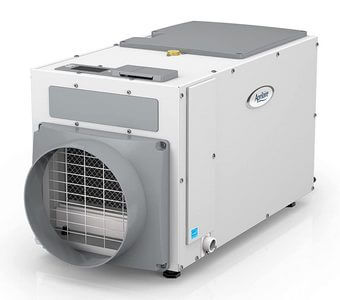
Check out this whole home dehumidifier on Amazon.
2. AlorAir Duct-able Version Basement/Crawl Space Dehumidifier
Unlike conventional options, the AlorAir Duct-able Version Dehumidifier grants you great control over your unique dehumidification needs. Lightweight and versatile, this dehumidifier lets you be flexible with transportation, placement, and storage. In addition, it is considerably more compact than the conventional basement-size dehumidifiers on the market.
This whole house dehumidifier has a capacity of 90 pints per day and comes in two airflow options: 210 and 350 cubic feet per minute (CFM). Hence, it works consistently and efficiently to remove moisture from the air inside your large home around the clock.
Moreover, it has a functioning humidity range between 35 and 90 percent, making it ideal for virtually any climate and season.
Admittedly, the installation process of this ducted dehumidifier for your basement, garage or large room can be back-breaking. But once it’s up and running, you can utilize the remote monitoring to minimize any further hassle.
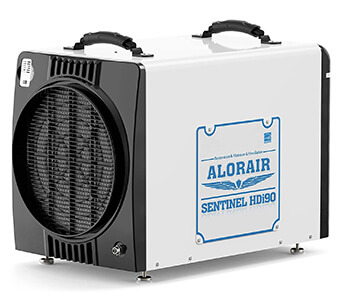
See this ducted dehumidifier on Amazon.
3. Honeywell Whole-Home Dehumidification System
The best ducted whole house dehumidifier is one that lets you set and forget, and that’s exactly what the Honeywell 90 Whole-Home Dehumidifier offers. With versatile installation options, low maintenance, and simple controls, you’ll barely have to lift a finger to dehumidify your entire home.
This inline dehumidifier has a capacity of 90 pints with an airflow of 400 CFM. It has a large operating range, working efficiently in temperatures ranging from 32 to 135 degrees Fahrenheit. Hence, you can expect a comfortable, moisture-free environment even on the hottest summer days.
Moreover, the Honeywell dehumidifier is easy to maintain, requiring only a filter change once a year. Furthermore, it offers an additional ventilation option, allowing you to vent air outside without using the dehumidification feature.
If you want something in a bigger size, the Honeywell dehumidifier also comes in a 120-pint capacity option. But if your coverage area is around 3,000 square feet, the 90-pint option will suffice.

Find this whole-home dehumidifier system on Amazon.
4. Santa Fe Ducted Whole House Dehumidifier
The Santa Fe Ducted Whole House Dehumidifier spares you the difficult choice between performance and energy efficiency. Indeed, this all-rounder dehumidifier is the most energy-saving 90-100 pint dehumidifier available on the market.
This energy-efficient powerhouse dehumidifier has a capacity of 98 pints. It successfully removes all the excess moisture from your home while drawing a mere 5.9 amps. Beyond dehumidifying, this inline ducted unit also filters microscopic allergens in the air, safeguarding its components and your lungs from unwanted irritants.
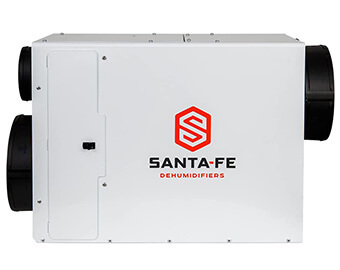
Read more about this inline HVAC dehumidifier on Sylvane.
How to Duct Your Whole House Dehumidifier
Whole house dehumidifiers typically come with ducting attachments to enable central dehumidification.
However, if you have a standalone or portable dehumidifier, it is possible to duct it through a wall by using return ducts, supply ducts, or both. This way, a standalone dehumidifier can double as a whole house dehumidifier.
Here’s how to duct your whole house dehumidifier:
- Acquire duct attachments tailored to your dehumidifier model.
- Prepare your wall by tracing or outlining the duct or vent you’ll be using.
- Attach the duct collars to your dehumidifier.
- Attach the duct collars to the wall with which you’re connecting the dehumidifier.
- Finish up by connecting the ductwork from the dehumidifier collars to the wall collars you just attached.
Final Thoughts
Excess humidity inside your house can become unbearable, especially during the summer months. But there’s only so much an air conditioner or even a portable dehumidifier can do before racking up your electricity bill.
What you need instead is a ducted whole house dehumidifier system that treats the humid air throughout your house.
Remember: the best ducted whole house dehumidifier is one that gives you the perfect balance between performance and energy efficiency. With a little bit of detective work, you’ll be able to figure out your dehumidification needs and find the ideal match for your house.

